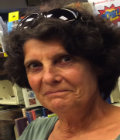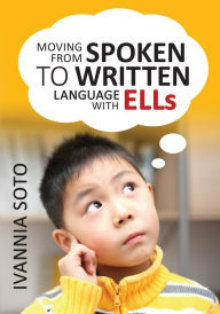Moving ELLs from Spoken to Written English
Moving from the Spoken to Written Language with ELLs
By Ivannia Soto
(Corwin, 2014 – Learn more)
 Reviewed by Glenda Moyer
Reviewed by Glenda Moyer
Experience isn’t always the best teacher. Even native English speaking teachers can feel quite inadequate in trying to effectively reach ELLs and meet standards. So “Spoken to Written” in the title grabbed my attention in my search for practical strategies to improve teaching ELLs. I was not disappointed one bit.
 With her experience as an ELL teacher in Los Angeles, professor of education and consultant, Ivannia Soto is well qualified to address mainstream classroom teachers who struggle to teach writing in content areas.
With her experience as an ELL teacher in Los Angeles, professor of education and consultant, Ivannia Soto is well qualified to address mainstream classroom teachers who struggle to teach writing in content areas.
Under the umbrella of College and Career Anchor Standards, she describes the qualities of “the hidden curriculum of academic discourse” that must be taught to enable students to develop the lifelong skill of respectful communication. Taking turns talking and listening carefully are two prime expectations that most students need to practice in any language. Soto cites the larger-than-respect reason: to be able to respond to others’ comments, not just proclaim one’s own ideas.
Oral language acts as a vital scaffold for collaborating, building understanding, and solving problems, which gives substance to recorded thinking. Against the backdrop of the progression in speaking and listening skills (from primary through grade 10), she concisely presents strategies to make standards “reasonable and accessible.”
Teacher friendly and packed with resources
This book is teacher-friendly, with helpful diagrams, procedures, graphic organizers, academic language stems, sample charts and exemplary lesson plans threaded through…
…think-pair-share
…reciprocal teaching
…ways to build background knowledge
…accountable talk with “the power walk”
…roles during Socratic seminar.
And that’s just the first chapter!
Chapters 2-5 integrate CCSS writing demands and the strategies Soto illustrated in chapter one. She presents Pauline Gibbons’ “Curriculum Cycle” method of explicitly introducing the key features of organization and grammar of each genre. She weaves Frayer’s method of scaffolding target vocabulary into lesson plans with think-pair-share graphic organizers and reciprocal teaching in each subsequent chapter.
Chapter 3 details how third graders write personal narratives about the familiar topic of themselves. Chapter 4 guides high school students to identify elements of argumentation incorporated in a fictional letter written to persuade Einstein, then respond in kind from the famous scientist’s perspective. A teacher’s “power walk” (listening in on group discussions) helps hold students accountable for assigned roles in small groups, validating student responses in classroom discussions later.
Chapter 5 centers on middle schoolers reviewing multiple sources to write an informational essay about creating a school garden. Their think-pair-share graphic organizers, used three times, form the outline for their writing.
Tools for in-depth learning
Soto claims teachers hold “the responsibility to design experiences for ELLs…to truly understand content and language in an in-depth way.” Her book is full of tools to aid them in reaching that worthy goal, since teachers are the key agents in how any strategy is implemented.
Teachers must intentionally plan questions ahead of time for language benefits to occur, explicitly teach academic language “that is not natural,” guard students’ time for learning a strategy and thinking more deeply, and model examining texts for supporting evidence. They model, structure, and schedule time to practice how partners respond to each other, when to record conversations, how to disagree politely.
As literacy coach, I am eager to interact with younger teachers about Soto’s practical application of standards to both ELLs and best teaching practices to inspire them to use their teaching tools and time more effectively and efficiently. I’ve seen instructors implementing think-pair-share and reciprocal teaching without realizing the depth to which students can go with them. My husband, a middle school science teacher, is always searching for ways to give and get more out of his students during class.
As a member of the elementary curriculum team, I anticipate interacting with both curriculum and teachers who implement it with enthusiasm about how to better reach our ELLs, both in speaking and writing. I plan to keep this book off my shelf and in my coach’s toolkit.
Glenda Moyer has inner city and international teaching experiences in her 23 years as teacher. Serving in an English immersion school in Bogota, Colombia for the past 19 years, she has taught kinderkids, 1st and 2nd graders, and students with learning differences. She “graduated’ to literacy coach four years ago. Because 80 % of her students are Colombians, she recently earned her TESOL certificate.
































